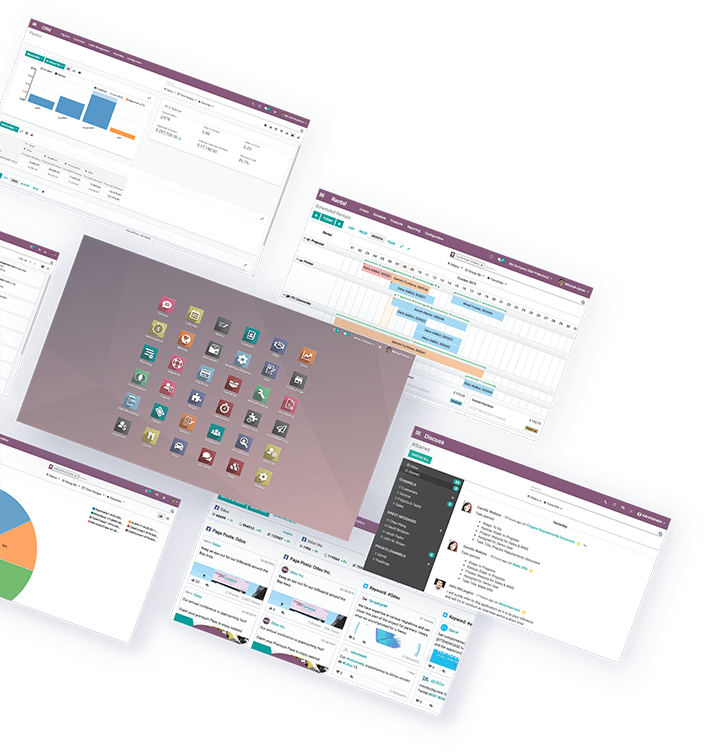What Is Digital Transformation?
The definition of digital transformation.
Digital transformation is the process of using digital technologies to create new — or modify existing — business processes, culture, and customer experiences to meet changing business and market requirements. This reimagining of business in the digital age is digital transformation.
It transcends traditional roles like sales, marketing, and customer service. Instead, digital transformation begins and ends with how you think about, and engage with, customers. As we move from paper to spreadsheets to smart applications for managing our business, we have the chance to reimagine how we do business — how we engage our customers — with digital technology on our side.
For small businesses just getting started, there’s no need to set up your business processes and transform them later. You can future-proof your organization from the word go. Building a 21st-century business on stickies and handwritten ledgers just isn’t sustainable. Thinking, planning, and building digitally sets you up to be agile, flexible, and ready to grow.
As they embark on digital transformation, many companies are taking a step back to ask whether they are really doing the right things. Read on for answers.

Digital transformation begins and ends with the customer.
This way to customer success with Trailhead
“Every digital transformation is going to begin and end with the customer, and I can see that in the minds of every CEO I talk to.”
Marc Benioff, Chairman and Co-CEO, Salesforce
See all ways to contact us


Before looking at the hows and what’s of transforming your business, we first need to answer a fundamental question: How did we get from paper and pencil record-keeping to world-changing businesses built on the backs of digital technologies?
- Process Transformation. …
- Business Model Transformation. …
- Domain Transformation. …
- Cultural/Organizational Transformation.
Digitalization is using digital data to simplify how you work.
The process of using digitized information to make established ways of working simpler and more efficient is called digitalization. Note the word established in that definition: Digitalization isn’t about changing how you do business, or creating new types of businesses. It’s about keeping on keeping on, but faster and better now that your data is instantly accessible and not trapped in a file cabinet somewhere in a dusty archive.
Think of customer service, whether in retail, field ops, or a call center. Digitalization changed service forever by making customer records easily and quickly retrievable via computer. The basic methodology of customer service didn’t change, but the process of fielding an inquiry, looking up the relevant data, and offering a resolution became much more efficient when searching paper ledgers was replaced by entering a few keystrokes on a computer screen or mobile device.
As digital technology evolved, people started generating ideas for using business technology in new ways, and not just to do the old things faster. This is when the idea of digital transformation began to take shape. With new technologies, new things — and new ways of doing them — were suddenly possible.
What’s the difference between digitization, digitalization, and digital transformation?
Digitization is the move from analog to digital.
Not so long ago, businesses kept records on paper. Whether handwritten in ledgers or typed into documents, business data was analog. If you wanted to gather or share information, you dealt with physical documents — papers and binders, xeroxes, and faxes.
Then computers went mainstream, and most businesses started converting all of those ink-on-paper records to digital computer files. This is called digitization: the process of converting information from analog to digital.

Finding and sharing information became much easier once it had been digitized, but the ways in which businesses used their new digital records largely mimicked the old analog methods. Computer operating systems were even designed around icons of file folders to feel familiar and less intimidating to new users. Digital data was exponentially more efficient for businesses than analog had been, but business systems and processes were still largely designed around analog-era ideas about how to find, share, and use information.
What is digital transformation – understanding the possibilities.
A key element of digital transformation is understanding the potential of your technology. Again, that doesn’t mean asking “How much faster can we do things the same way?” It means asking “What is our technology really capable of, and how can we adapt our business and processes to make the most of our technology investments?”
Before Netflix, people chose movies to rent by going to stores and combing through shelves of tapes and discs in search of something that looked good. Now, libraries of digital content are served up on personal devices, complete with recommendations and reviews based on user preferences.
Streaming subscription-based content directly to people’s TVs, computers, and mobile devices was an obvious disruption to the brick-and-mortar video rental business. Embracing streaming also led to Netflix looking at what else it could do with the available technology. That led to innovations like a content recommendation system driven by artificial intelligence. Talk about making the most out of your IT department!

Adapt your business to leverage digital transformation.
Similarly, digital transformations have reshaped how companies approach customer service. The old model was to wait for customers to come find you, whether in person or by calling an 800 number. But the rise of social media has changed service much like it’s changed advertising, marketing, and even sales and customer service. Progressive companies embrace social media as a chance to extend their service offerings by meeting customers on their platforms of choice.

Digital Transformation Since 2018
www.interfisica.com
Integration of sales tools, website, e-commerce, and CRM; now they have more control of their sales and optimize the shipping time
Interfisica
New York, NY
Digital Transformation Since 2016
www.delsyencomiendas.com
Digitalization of the shipping management, payments, and inventory; now they are tracking in real time the status of the orders


